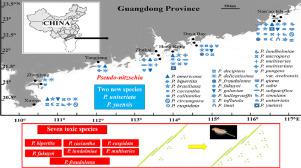Harmful Algae ( IF 6.6 ) Pub Date : 2020-09-10 , DOI: 10.1016/j.hal.2020.101899 Huan Chang Dong , Nina Lundholm , Sing Tung Teng , Aifeng Li , Chao Wang , Yang Hu , Yang Li

|
The diatom genus Pseudo-nitzschia, which has been associated with amnesic shellfish poisoning events globally, is also one of the key harmful microalga groups in Guangdong coastal waters, off the north coast of the South China Sea. In order to explore the diversity and toxigenic characteristics, Pseudo-nitzschia isolates were established. Based on a combination of morphological and molecular features, in total 26 different Pseudo-nitzschia taxa were identified, including two new species, P. uniseriata H.C. Dong & Yang Li and P. yuensis H.C. Dong & Yang Li. Morphologically, P. uniseriata is unique by having striae mainly comprising one row of poroids, which are simple without divided hymen internally, and each poroid containing one, seldom two sectors. Pseudo-nitzschia yuensis is characterized by having striae comprising one to two rows of poroids. In biseriate striae, the poroids are polygonal and irregularly distributed, and a discontinuous row of poroids may be present in the middle. In uniseriate striae, the poroids usually contain 1–5 sectors. Both taxa are well differentiated from other Pseudo-nitzschia species in phylogenetic analyses inferred from ITS2 sequence-structure information. Pseudo-nitzschia uniseriata is sister to P. lineola, whereas P. yuensis forms a group together with P. micropora and P. delicatissima. When comparing ITS2 secondary structure, two hemi-compensatory base change (HCBCs) are found between P. uniseriata and P. lineola. One compensatory base change (CBC) and four HCBCs are found between P. yuensis and P. delicatissima, and there is one CBC and five HCBCs between P. yuensis and P. micropora. The ability of cultured strains to produce particulate DA (pDA) revealed production of pDA in twenty-nine strains belonging to seven species: P. bipertita, P. caciantha, P. cuspidata, P. fraudulenta, P. fukuyoi, P. lundholmiae and P. multiseries. This is the first report of P. bipertita being toxic, with pDA content of 15.6 ± 2.1 fg cell–1. The presence of brine shrimps significantly increased pDA content in P. cuspidata, P. fukuyoi, P. lundholmiae and P. multiseries 1.4 to 7 times, and induced pDA production in P. fraudulenta from below detection limit to 17.5 ± 1.6 fg cell–1. The highest pDA concentration, 4830.5 ± 120.3 fg cell–1, was detected in P. multiseries, a level much lower than previous reports on P. multiseries from North America and Europe. Overall, the cellular toxin levels in Pseudo-nitzschia spp. were low in Guangdong coastal isolates.



























 京公网安备 11010802027423号
京公网安备 11010802027423号